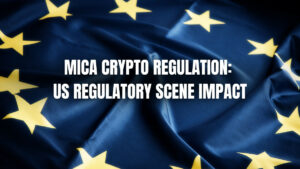For those operating in the world of cryptocurrency, the European Union’s adoption of the Markets in Crypto Assets (MiCA) and Transfer of Funds regulations is being viewed as a crucial step forward. By introducing the first major attempt at providing a comprehensive set of rules for crypto companies, the EU is looking to end the “Wild West” era for the industry – effectively setting a global standard. However, these regulations remain in stark contrast to the current practices of other countries, most notably the United States.
As the world’s largest cryptocurrency market and economy, the US remains beholden to its disjointed and counterproductive set of regulations for crypto assets. Up until now, confusion has reigned supreme amidst an unofficial “whole-of-government” approach. Inconsistency between the authority of different federal committees, as well as the SEC’s murky definition of digital assets, sets the stage for difficulty, risk, and uncertainty – characteristics that crypto players have found to be antithetical to the principles of the sector, such as decentralization, autonomy, and privacy.
It’s Not the Ending for Crypto Regulations Between the US and Europe Yet
The rift between Europe and the US over crypto regulations isn’t likely to close anytime soon. Of course, US lawmakers have the ability to build their own regulations, a notion bolstered by the news that the European Union’s MiCA rules still need official approval from the supra-governmental body, the EU Council. But US regulators have shown little inclination to follow suit.
Since the dawn of crypto, US regulatory discord has weighed heavily on the crypto markets – a factor that’s been exemplified in the latest bout of downward price movements for Bitcoin. From its high near $31,000 last week, BTC is now trading at about the $28,000 mark – a two-day swoon described by Mark Connors, head of research at Canadian crypto asset manager 3iQ, as due largely to the US regulatory environment and Asia’s heavy market liquidity.
US Become A Clear Loser?
The news of slipping employment numbers, as well as the National Association of Realtors monthly report showing a drastic dip in home prices, adds to investor uncertainties and suggests that the US economy may be heading towards a recession. And with many US digital asset companies opting to get licensed in Bermuda to launch exchanges as early as next week, Connors believes the US has become a “clear loser” in the present market. His outlook for the rest of 2023 puts “more volatility” in the cards, but perhaps a more tame variety than the roaring upwards climb of the past year.
MiCA’s Ambitious Scope For Global Crypto Market
The MiCA regulations released by the European Union are ambitious in scope and could have far-reaching effects on the global crypto market. Already, some have balked at the reporting standards, a measure put in place for customer safety and national security, which weakens user privacy as a necessary cost. But, despite this inherent flaw, the framework holds the potential to revolutionize the industry, allowing companies to operate with a greater understanding of their responsibilities if they want to serve customers in the EU.
The recent adoption of the Markets in Crypto Assets (MiCA) and Transfer of Funds regulations in the European Union has brought fruition to the long-held dreams of crypto players everywhere – the end of the “Wild West” era for digital assets and the introduction of a comprehensive set of rules. Yet, while Europe is blazing a trail in the crypto scene, the United States remains mired in disjointed and counterproductive regulations of crypto assets – a discrepancy that’s had dramatic consequences for the US economy and its leading role in the crypto market.
EU Continue To Push Forward
The European framework, imposed to ensure consumer safety and national security, requires that crypto companies operating within the 27-nation bloc obtain a license and comply with money laundering and terrorism finance safeguards. This new global standard is viewed as a critical step forward for the industry, and the EU hopes that its success will inspire other countries to implement similar regulations.
But while the EU pushes ahead, the US trails behind with a whole-of-government approach that lacks any definitive rules. This inconsistent landscape has created significant uncertainty for US crypto players, making it difficult for them to properly understand their responsibilities when dealing with digital assets.
MiCA: A Key to Spark Crypto Regulations
These regulatory misgivings have consequently put a severe strain on the US economy. Bitcoin’s two-day swoon to its recent low near $28,000 can be attributed largely to the US regulatory environment and market volatility due to Asia’s heavy liquidity. Major job and housing market declines have also added to investor worries, with US digital asset companies now voting with their feet and getting licensed in Bermuda to launch exchanges.
It’s clear that US lawmakers still have a lot of work to do in order to catch up to Europe in the crypto scene. But the introduction of the MiCA regulations could be the spark that leads to a watershed moment for the US in terms of crypto regulations. Whether it proves to be a catalyst or an impetus, the future of crypto law in the United States is still uncertain.
